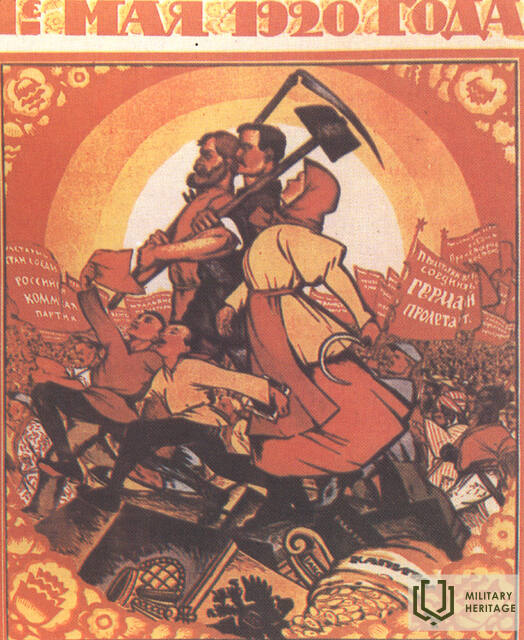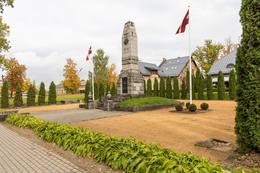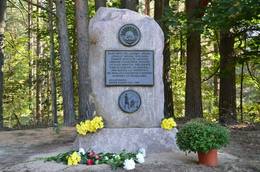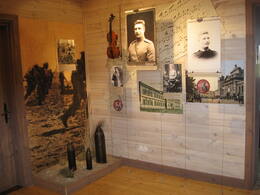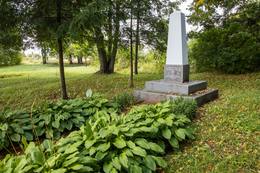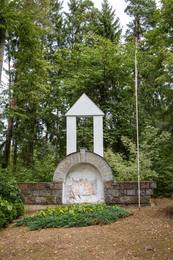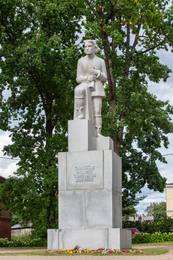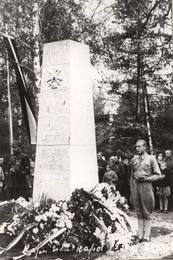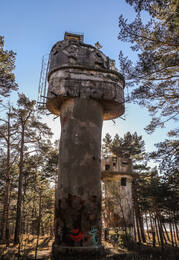Sowjetrepublik Lettland, 1919-1920
I Unabhängigkeitskriege
Sozialistische Sowjetrepublik Lettland – Sowjetregime in Lettland. Sowjetlettland war bis zum 1. Juni 1919 teilweise souverän, danach gehörte es faktisch zu Sowjetrussland.
Zugehörige Zeitleiste
Zugehörige Objekte
Denkmal für die gefallenen Helden der Gemeinde Gulbene für die Freiheit Lettlands
Im historischen Zentrum von Gulbene gelegen, gegenüber der evangelisch-lutherischen Kirche von Gulbene.
Denkmal für die Opfer der Unruhen von 1905, die im Ersten Weltkrieg und im Lettischen Unabhängigkeitskrieg gefallenen Mitglieder der Gulbene-Gemeinde sowie die Opfer des Maliena-Tribunals. Das Denkmal wurde von E. Ābeltīns entworfen und 1929 gegenüber der evangelisch-lutherischen Gulbene-Kirche enthüllt. Nach dem Zweiten Weltkrieg wurde ein fünfzackiger Stern auf dem Denkmal angebracht, später – auf dem Sockel – eine Gipsfigur eines sowjetischen Soldaten, die in Bronze gegossen wurde. Hinter dem Denkmal wurde ein Friedhof für gefallene sowjetische Soldaten angelegt. Als 1969 der neue Friedhof für im Zweiten Weltkrieg gefallene sowjetische Soldaten im Spārīte-Park eröffnet wurde, wurden die sterblichen Überreste der Gefallenen dorthin überführt, der Standort des Denkmals jedoch eingeebnet. Im Herbst 1989 wurden die Fundamente des Denkmals freigelegt und die 1928 eingemauerte Kapsel mit der Inschrift geborgen. Das Denkmal wurde 1992 restauriert (Bildhauer O. Feldbergs).
Zwischen dem 24. Dezember 1918 und dem 31. Mai 1919, als das 1. (4.) Valmiera-Infanterieregiment Gulbene von den Bolschewiki befreite, beherbergte die Kirche das Revolutionäre Militärgericht und den Arbeiterklub von Maliena (Vecgulbene). Dessen Tätigkeit zeichnete sich durch die Härte seiner Urteile und die hohe Anzahl an Todesurteilen aus, oft wegen geringfügiger Vergehen – 349 Fälle wurden untersucht, in denen 606 Personen angeklagt waren.
Eine Gedenkskulptur ist zu sehen.
Ein Ort des Gedenkens an die Ereignisse des lettischen Unabhängigkeitskrieges in Mārupe
Gelegen in der Gemeinde Mārupe, an der Straßenseite zwischen dem Golfclub „Viesturi“ und dem Boži-Stausee.
Das Denkmal wurde 2013 enthüllt. Die Geschichte des Gebiets ist mit der Schlacht der lettischen Armee gegen Bermonts Truppen im Jahr 1919 verbunden. In der Nähe des Hauses Adienņi waren Einheiten der lettischen Armee in Kampfstellungen aufgestellt.
Während des Unabhängigkeitskrieges fehlte der lettischen Regierung aufgrund der schwierigen Lage die Möglichkeit, die Armee mit dem Nötigsten zu versorgen. Das Erscheinungsbild und die Bewaffnung der Soldaten variierten stark. Die Versorgung hing meist von der Fähigkeit der Soldaten ab, sich selbst zu versorgen. Ende September/Anfang Oktober 1919 traf ein Militärauftrag aus Großbritannien ein, um die Engpässe zu beheben. Einen Monat später wurde auch eine Lieferung englischer Waffen geliefert. Schon bei den ersten Lieferungen wurde deutlich, dass Großbritannien überflüssige Vorräte loswerden wollte. Auch schmutzige, abgetragene Kleidung und Schuhe wurden geliefert, die oft zu klein waren. Das Tragen ungeeigneter Schuhe führte zu gesundheitlichen Problemen, die die Kampfkraft der Soldaten beeinträchtigten. Kleidung wurde geflickt und geflickt. Das wichtigste gemeinsame Symbol war das elfstrahlige Sonnensymbol auf der Mütze und ein rot-weißer Verband um den linken Arm.
Heute können hier mehrere Gedenkstätten besichtigt werden. Die Stätten sind Teil einer landschaftlich reizvollen, speziell angelegten historischen und naturkundlichen Wanderroute.
Führer Mikķelis Jakunovs, +371 28353679.
Oskars-Kalpaks-Museum und Gedenkstätte „Airītes“
Das Oskars-Kalpaks-Museum und die Gedenkstätte „Airītes“ liegen zwischen Saldus und Skrunda, unweit der Fernstraße A9. Die Ausstellung bietet umfassende Informationen über Oberst Oskars Kalpaks, das von ihm kommandierte Bataillon und beleuchtet die Geschichte der nationalen Streitkräfte Lettlands sowie die Entstehung der Gedenkstätte „Airītes“. Vorgestellt wird Oberst Oskars Kalpaks als Mensch, als Soldat und als Kämpfer für die Unabhängigkeit Lettlands. Die Exponate werden durch Tonaufnahmen von Zeitzeugen ergänzt (Lettisch, Englisch und Deutsch). Sie unterstreichen die große Bedeutung der historischen Abläufe von 1918-1919 für die Durchsetzung der staatlichen Unabhängigkeit Lettlands. Das Museumsgebäude ist renoviert. Der Eintritt ist frei, Führungen sind kostenpflichtig.
Die Gedenkstätte verfügt über einen Picknickplatz, einen Park mit Hindernisparcours und einen Seminarraum für bis zu 30 Personen. Ferner werden verschiedene Workshops angeboten.
Denkmal für die Soldaten des 1. Infanterieregiments von Liepāja am Ort der Schlachten von 1919
Das Hotel liegt im Dorf Meža Strodi, Gemeinde Murmastiene, Region Madona, 6 km von Varakļāni entfernt.
Das Denkmal für den Freiheitskampf befindet sich am Ort der Schlacht des 1. Infanterieregiments von Liepāja, wo es 1919 gegen die „Rote Armee“ kämpfte. Unweit davon wurde der Einheimische Aleksandrs Lakstīgala in einer Schlacht schwer verwundet. Man fand ihn tot in der Nähe eines Hauses. Aus diesem Grund wurde dieser Standort für das Denkmal gewählt.
Am 16. August 1936 wurde ein Granitdenkmal (wie es in der damaligen Presse genannt wurde) zum Gedenken an die Freiheitskämpfe enthüllt. In die Inschrift war eingraviert: „Der Ort der Schlachten, Opfer und Siege des 1. Infanterieregiments Liepāja in Latgale, am 26. August 1919. Wir erkauften jeden Winkel unseres Vaterlandes mit unserem Blut – es gehört nun uns.“ Es wurde von der Führung des Garderegiments Rēzekne errichtet und vom Oberpriester des Regiments, Vincents Tomašūnas, zusammen mit dem örtlichen Pfarrer Kalinkas geweiht. Die Einweihungsparade wurde vom Kommandeur der Zemgale-Division, Kavalier des Lāčplēsis-Ordens, Žanis Bachs, abgehalten. 1950 wurde es abgerissen und zerstört. Am 16. November 1996 wurde das restaurierte Denkmal feierlich enthüllt, ebenfalls zu Ehren des 78. Jahrestages der Ausrufung der Republik Lettland.
Denkmal „Herold von Tālava”
Befindet sich im Zentrum von Rūjiena.
Die drei Meter hohe Statue eines alten lettischen Gardesoldaten, aus grauem finnischem Granit gehauen und „Tālavas-Trompeter“ genannt, steht auf einem drei Meter hohen Granitsockel. Das Denkmal selbst erreicht eine Gesamthöhe von 7,5 Metern. In den ersten Skizzen und Modellen hatte K. Zemdega dem Krieger ein Schwert in die Hand gegeben, das später durch eine Trompete ersetzt wurde. Das Denkmal wurde am 15. August 1937 enthüllt.
Dieses Denkmal spiegelt die schwierige Situation bei der Gründung unseres Staates und unserer Armee sowie die Bewertung dieser Ereignisse wider. Unmittelbar nach der Ausrufung des lettischen Staates begann der Einmarsch der Roten Armee, und die provisorische Regierung von Kārlis Ulmanis suchte Zuflucht in Liepāja. Im Februar 1919 begann mit Unterstützung der estnischen Armee die Befreiung Lettlands aus dem Norden. Die ersten Mobilisierungen der in Tērbatas aufgestellten lettischen Truppen fanden im Raum Rūjiena statt. Unter dem Kommando von Oberst Jorģis Zemitāns wurde daraus die Nordlettische Brigade. Diese kämpfte nicht nur gegen die Bolschewiki, sondern auch gegen die Landeswehr und die Eiserne Division in den Schlachten von Cēsis. Die im Raum Rūjiena mobilisierten nordlettischen Soldaten kämpften auch in den folgenden Schlachten des Unabhängigkeitskrieges. Nach dem Krieg gebührten die größten Lorbeeren für den Sieg General Jānis Balodis und der von ihm befehligten Südlettischen Brigade, die Nordlettische Brigade geriet jedoch oft in Vergessenheit. Auch die Errichtung des geplanten Denkmals für die Nordlettische Brigade in Rūjiena dauerte lange. Das 1937 enthüllte Denkmal wurde offiziell als Denkmal für die Befreiung der Region Rūjiena und zum Gedenken an die gefallenen Soldaten beworben, ohne zu erwähnen, dass alle Regimenter der Nordlettischen Brigade ihren Ursprung in Rūjiena hatten.
Das Denkmal ist nicht nur eine beliebte Touristenattraktion für lettische und estnische Touristen und gewissermaßen Ausgangspunkt für den Besuch mehrerer anderer Gedenkstätten des Unabhängigkeitskrieges in Rūjiena, sondern das "Tālavas tauretājs" ist auch ein Anlaufpunkt für Besuche von estnischen und lettischen Staats- und Kommunalbeamten verschiedener Ebenen.
Das Rūjiena-Befreiungs- und Gefallenen-Soldaten-Denkmal, besser bekannt als „Tālavas tauretājs“, wurde am 29. Oktober 1998 als Kunstdenkmal von nationaler Bedeutung in die Liste der staatlich geschützten Kulturdenkmäler aufgenommen (Denkmalschutzregistrierungsnummer 4522).
Karosta, der Militärhafen von Liepāja (die Tour)
Karosta ist das größte historische Militärgebiet im Baltikum und nimmt heute fast ein Drittel des gesamten Stadtgebiets von Liepāja ein. Der ehemalige Kriegshafen ist ein einzigartiger Militär- und Festungsanlagenkomplex an der Ostseeküste, der historisch und architektonisch nicht nur für Lettland außergewöhnlich ist. Zum militärhistorischen Erbe in Karosta gehören die Nordmole, die Nordforts, der Redan-Vorposten, das Gefängnis und der Wasserturm des Kriegshafens, die orthodoxe St. Nikolaus-Marine-Kathedrale sowie die Oskars-Kalpaks-Brücke.
Zugehörige Geschichten
Die Schlacht von Cēsis am Ufer des Amata-Flusses
An der Brücke über die Amata greift die deutsche Landeswehr einen estnischen Panzerzug an, der zu Verhandlungen eingetroffen ist. Die Esten eröffnen das Feuer, die Deutschen werden zurückgeschlagen, und der Panzerzug kehrt nach Cēsis zurück.
Anfang, Verlauf und Ende der Schlacht von Cēsis
Der Sieg in der Schlacht bei Cēsis sollte sich als Wendepunkt im lettischen und estnischen Kampf um die Unabhängigkeit ihres Landes erweisen. Er beendete die Pläne der Regierung von Andrievs Niedra und des deutschen Generals Rüdiger von der Goltz zur Eroberung des Baltikums. Stattdessen nahm die lettische Provisorische Regierung unter Kārlis Ulmanis ihre Tätigkeit in Liepāja wieder auf.
Über Oskars Kalpaks letzte Schlacht bei Airīte
Oberst Kalpaks war in Militärkreisen eine angesehene Persönlichkeit und ein echter Patriot. Es war der Geist des Patriotismus und ein unglücklicher Zufall, der zu dem fatalen Zusammenstoß zwischen ihm und den deutschen Bataillonen führte, der leider mit dem Tod von Oberst Kalpaks endete.
Die estnische Marine unterstützt die lettischen Streitkräfte während des Unabhängigkeitskrieges.
Am 23. Juni feiern die Esten den Tag des Sieges und gedenken damit des gemeinsamen lettisch-estnischen Sieges in der Schlacht bei Cēsis. Die estnische Marine spielte bei diesem Sieg eine bedeutende Rolle. In diesem sogenannten Landeswehrkrieg bedrohte sie mit ihrem mutigen Einsatz und präzisen Artilleriefeuer an der Mündung der Düna die wichtigsten Nachschubwege der deutschen Truppen über die Düna in unmittelbarer Nähe von Riga.
Über den ersten Oberbefehlshaber der lettischen Armee, Dāvids Sīmansons
Die Essays im Buch „Kommandeure der lettischen Armee“ überzeugen uns davon, dass die Geschichte maßgeblich von einzelnen Persönlichkeiten geprägt wird. Obwohl sie nur kurze Zeit im Zentrum der wichtigsten historischen Ereignisse standen, leisteten wahre lettische Patrioten mit ihrer reichen militärischen Erfahrung einen bedeutenden Beitrag zur Aufstellung und Stärkung der lettischen Armee und zu den Wendepunkten der Geschichte.
Diese Geschichte handelt vom ersten Oberbefehlshaber der lettischen Armee, Dāvids Sīmansons (1859-1933).
Kap Akmeņrags und das Schicksal von "Saratow"
1919 Liepaja ist für kurze Zeit die Hauptstadt Lettlands gewesen, denn während der Freiheitskampfe war die Provisorische Regierung auf dem Schiff "Saratow" stationiert. Die Saratow brachte die Provisorische Regierung nach ihrer Befreiung nach Riga. iele Menschen wissen nicht, dass die Geschichte eines so wichtigen Schiffes für uns auf See in Akmenrags endete.




